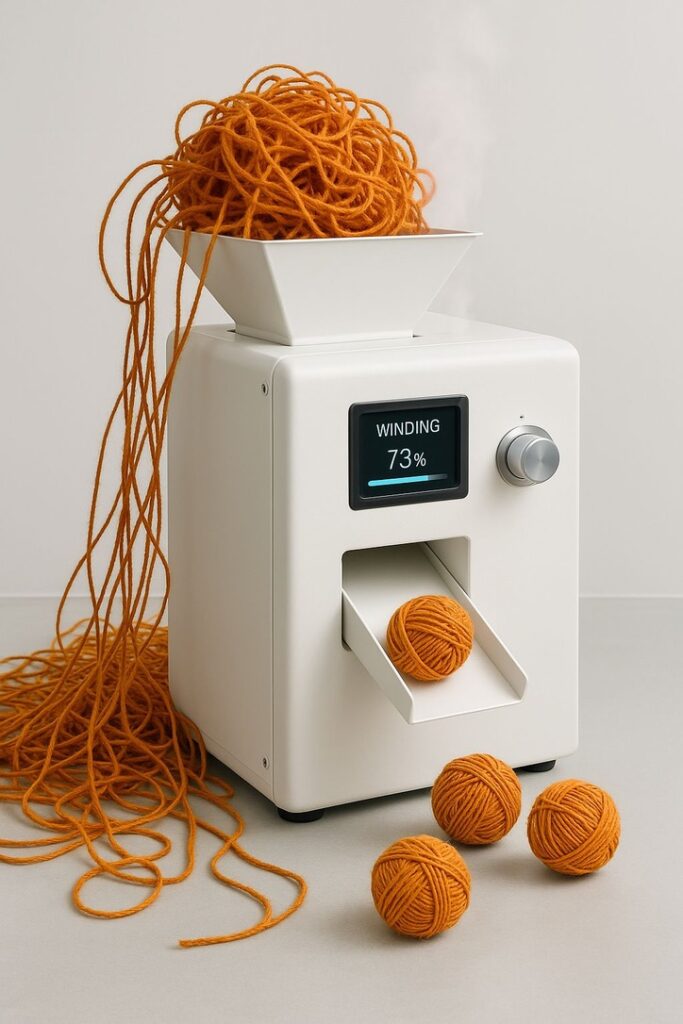“The only mistakes we make”, we’re told, “are the ones we fail to learn from”.
So what was the lesson here?
A mis-stranded skein of yarn was unknowingly loaded onto the swift for ball winding. In a matter of seconds, the whole thing was a snarled up spaghetti-like mess of tangles. The customer smiled nervously about an appointment she had to get to. I tried to reassure her and suggested she come back for it later on. What followed was a full working day of nothing but untangling and hand winding all 800 meters of the lace weight superwash merino. I went home that evening exhausted, humiliated and fed up.
It took me most of a broken night’s sleep to work it out, but finally I knew what the answer was.
What this shop needs, I realised with a blinding bolt of Mrs Armitage’s obviousness, is a Yarn Detangler!
The embarrassment and taboo surrounding bad winding experiences means we only ever learn of a fraction of those that actually happen, but talk to almost any knitter, and you’ll discover that tangles continue to blight the knitting and projects of so many.
The need was clear, the solution, less so. My breakthrough moment came 2 years later from a chance encounter with a Greenlandic justice campaigner on the Barking train from Gospel Oak, who introduced herself as Pip. She offered to help me unwrangle a mess of guernsey yarn that had formed in my project bag. I told her about this long-standing dream I had for creating a Detangler, only to discover that as well as being an activist and prolific knitter Pip was also an engineering graduate from Nuuk University with a special interest in marine tangles. Her final degree research project was a fascinating interdisciplinary investigation into the ways in which the Greenlandic offshore fishermen’s traditional methods for untangling ropes, can be applied to strategies for political mobilisation.
“This Detangler of yours,” she explained, “it’s just about applying machine learning to a reverse engineering of the tangle. Look, a tangle is just a series of loops, like knitting but more disorganised. We have the tools to resolve it. There’s no reason not to repurpose something like Apple’s FaceID TrueDepth camera technology. If you set it up smartly, you can train the machine, to read the tangle, index the loops, and ultimately reverse edit them. The rest is just ball winding.”
Just before getting off the train for her strategy workshop in Wanstead, she scribbled a name and number onto the corner of a crumpled leaflet. “Contact Minik. Tell them Pipaluk says Hi and that I’m fine. They can make this happen.”
I never saw her again, but the contact led me to Minik and their extraordinary team at Naatsiiat, a workers cooperative of visionary creatives from Nuuk. And now nearly 7 years since that fateful skein of laceweight merino, we finally have a Version 1.0 of the WindUp (the branding team rejected ‘Detangler’ on account of its association with hair care products).

How does it work? Drop your tangled skein into the hopper at the top, and set the machine to ‘auto’. It then goes through 3 stages: 1. Analysis 2. Untangle 3. Winding, before delivering the yarn in perfectly wound balls. The length of the process varies according to the length and complexity of the tangle, but currently ranges from 13 to 47 minutes per 100m of yarn.
This first Alpha version of the WindUp is not yet ready for home use – it will initially only be available to yarn stores to offer as a value-added service to knitters. Assuming investors are impressed with progress so far, the development roadmap plans for a more affordable 2.0 ‘Mini’ model in the Spring of 2026. Version 3.0 will focus on speed so that ultimately the WindUp can become a viable alternative to hand cranked skein-winders. Development, design, production and any consequential profits will continue to be shared equally with the Naatsiiat Workers Coop, with a portion kept by for the fight for justice in Greenland.
Happy Tangle-free April 1st Everyone!

